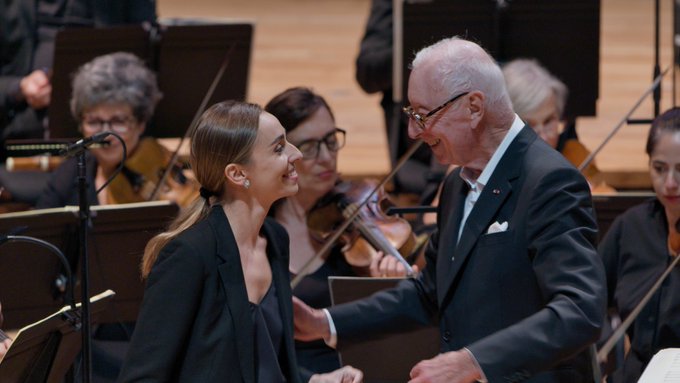In epochs of
information overload (or overlook), salvation comes from
conferences like the
HDPS 2010 workshop organized on 21 and 22 of June 2010 on
High Dimensional Problems and Solutions, with Ron DeVore (Dep. of Mathematics,Texas A&M University, USA, recipient of the Foundation's Research Chaire of Excellence 2009) and Albert Cohen (UPMC, LJLL). Indeed:
Several important areas of science are confronted with the having to recover a functions of many variables either from large data sets or from complex mathematical models. Such recovery is inhibited by what is commonly called the 'curse of dimensionality' which says the numerical approximation of such a function will require inordinately more computation as the number of active variables increases. This workshop bring together the world's leading experts on high dimensional problems to discuss their recent research in areas such as manifold learning, stochastic and parametric PDEs, and optimal recovery.
The program was terrific:
- Steve Smale (City University of Hong Kong) "Hodge Theory"
- Mauro Maggioni (Duke) "Multiscale geometric methods for the analysis of points clouds"
- Gilad Lerman (Univ. of Minnesota) "Multi-Manifold Data Modeling: Foundations and Applications"
- Christoph Schwab (ETH Zurich) "Sparse Tensor Approximations of PDEs on high-dimensional parameter spaces"
- Yvon Maday (Paris VI) "Reduced basis and magic point for high dimensional approximation problems"
- Wolfgang Dahmen (RWTH Aachen) "A greedy approach for the reduced basis method - Convergence rates"
- Emmanuel Vasquez (Supelec) "Gaussian processes, RKHS and their applications to computer experiments"
- Przemek Wojtaszczyk (Univ. Warsaw) "Approximation of functions of few variables in high dimension "
- Dominique Picard (Paris VII) "LOL: thresholdings and high dimensions"
- Rob Nowak (Univ. of Wisconsin) "Adaptive and Nonlinear Designs for Large-Scale Multiple Hypothesis Testing"
- Martin Wainwright (Berkeley) "Recovery problems in high dimensions: A unified analysis of estimators with decomposable regularizers"
- Stephane Mallat (Polytechnique) "High dimensional classification by recursive interferometry"
As i could not attend, i am glad that most of it is now available as webcasts (gather at
Foundation Sciences Mathématiques de Paris), as potential take-aways for summer holidays:
Mauro Maggioni (Duke): "Multiscale geometric methods for the analysis of points clouds",
Steve Smale (City University of Hong Kong): "Hodge Theory",
Stephane Mallat (Polytechnique): "High dimensional classification by recursive interferometry",
Martin Wainwright (Berkeley): "Recovery problems in high dimensions: A unified analysis of estimators with decomposable regularizers",
Rob Nowak (Univ. du Wisconsin): "Adaptive and Nonlinear Designs for Large-Scale Multiple Hypothesis Testing",
Wolfgang Dahmen (RWTH Aachen, joint work with Peter Binev, Albert Cohen, Ronald DeVore, Guergana Petrova, and Przemyslaw Wojtaszczyk): Convergence Rates for Greedy Algorithms in Reduced Basis Methods,
Peter Binev (Univ. Caroline du Sud): "Sparse Occupancy Trees",
Gilad Lerman (Univ. of Minnesota): "Multi-Manifold Data Modeling: Foundations and Applications",
Emmanuel Vazquez (Supelec): "Gaussian processes, RKHS and their applications to computer experiments",
Yvon Maday (UPMC): "Reduced basis and magic point for high dimensional approximation problems",
Przemek Wojtaszczyk (Univ. de Varsovie): "Approximation of functions of few variables in high dimension",
For dessert, a smoother video on "are soap bubbles all round?"
Thank you
Igor for referencing.
 Coming back from Orléans (France) on March 2010 for the Second conference "Mathematics and Image processing" (Deuxième colloque "Méthodes mathématiques pour l’image") organized at MAPMO. Having presented stuff on Statistical estimators based on Stein's principle for M-band wavelets and filter banks (abstract, slides, codes). Waiting in a train, staring again (and pixing) at the eight-seat compartment numbering once discussed here.
Coming back from Orléans (France) on March 2010 for the Second conference "Mathematics and Image processing" (Deuxième colloque "Méthodes mathématiques pour l’image") organized at MAPMO. Having presented stuff on Statistical estimators based on Stein's principle for M-band wavelets and filter banks (abstract, slides, codes). Waiting in a train, staring again (and pixing) at the eight-seat compartment numbering once discussed here.  Since Igor Carron posted this Magic trick for summer vacations on Nuit Blanche (constest won by Laurent Jacques), I propose the following one again. Pictures attest the realness of the data, in contrast to Igor thought experiment (vicious tackle). Seat numbering is split in odd and even (unlike in six-seat cars), face-to-face, as:
Since Igor Carron posted this Magic trick for summer vacations on Nuit Blanche (constest won by Laurent Jacques), I propose the following one again. Pictures attest the realness of the data, in contrast to Igor thought experiment (vicious tackle). Seat numbering is split in odd and even (unlike in six-seat cars), face-to-face, as:



